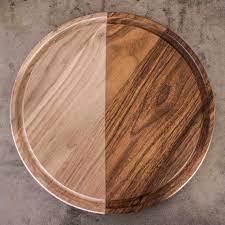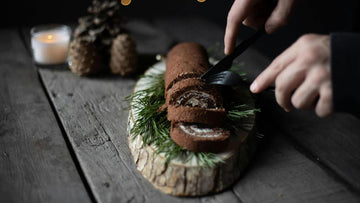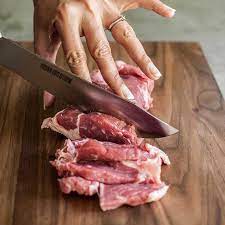Round shape cutting board easy to maintain and use.
by Jerry Barker on Dec 18, 2023

The History and Evolution of Round Shape Wood Cutting:
Round wood cutting boards are one of the oldest and most popular shapes that have been used in kitchens throughout history.
Early Round Cutting Boards:
- The earliest form of these round cutting boards would just serve as the place where cheese, bread, meat, and vegetables are chopped, sliced and served.
- Maple or walnut is the typical timber used as it was hard, durable, and easy to clean.
- Eventually, larger round cutting boards were used for roasting and other cutting of larger meat portions.
The Advent of Handles and Juice Grooves:
- As cutting board design advanced, round boards started being made with integrated handles cut out from the wood itself, making them easier to lift and manoeuvre.
- Juice grooves carved around the perimeter also helped keep mess contained and the board from slipping.
Modern Innovations:
Today, round cutting boards showcase innovative features like:
- Reversible designs with different surface textures on each side
- Round boards integrated into serving platters or tray bases
- Self-contained boards with collapseable handles for compact storage
- Round end-grain boards made by aligning wood grain vertically for added durability
This evolution reflects the timeless appeal of the round cutting board's form factor and its adaptability to modern kitchen needs.
Round Cutting Board with handle:
A round cutting board with an integrated handle is a very convenient and useful style, as the handle makes the board easy to lift, flip, and move around the counter or between prep and serving areas.
Ergonomic Handle Styles:
- The handle on a round cutting board may be an open curved shape or a closed loop design.
- Handles strategically located on one side or along the perimeter offer good leverage for grabbing and picking up.
- The handle should be comfortable to grip and of a sufficient size to get your fingers around.
Added Functionality:
- Look for a round cutting board with handle holes wide enough to accommodate hooks for hanging storage.
- Some handles flip down flush with the board so the whole thing can lay flat for serving after chopping.
Materials and Care:
Round cutting boards with handles come in end-grain and edge-grain wood, bamboo, acrylic, and more. Go for wood handles for warmth and style or plastic/rubber for moisture resistance.
Hand wash handles carefully, avoid soaking, and hang to dry thoroughly after each use to prevent growth of bacteria in crevices.
With the right handle in the right spot, a round cutting board becomes that much more user-friendly.
Extra Large Round Cutting Board:
For chopping whole roasts, carving turkeys, bread boarding dough, and other sizable kitchen tasks that benefit from ample surface area, an extra large round cutting board is a must-have.
More Prep Room:
- An oversized round cutting board provides plenty of continuous open counter space at least 18-20 inches in diameter for expansive food prep jobs.
- The consistently round shape creates an unbroken chopping orbit without hard corners getting in the way.
- Clean lines and an expansive profile give an upscale and spacious look to the kitchen.
Adapts to Any Task:
- A spacious board easily accommodates several bowls or platters around the perimeter during food assembly or transfer.
- It provides a roomy work surface for rolling out pie dough, pasta, or cutting whole vegetables.
- Leave an open area on one side for prepped ingredients while actively chopping on the other.
Premium Materials:
Oversize round boards meant for heavy prep work need to stand up to wear and tear. Opt for:
- Thick end-grain hardwoods that resist knife nicks
- Durable bamboo able to absorb plenty of shock
- Easy-care Richlite stone composite that won't harbor bacteria
A quality extra large round cutting board is a multipurpose kitchen tool perfect for those who love cooking in quantity and entertaining.
Large Round Cutting Board with Handle (if you want to learn more read this article)
For home cooks wanting a versatile and portable prep surface" a large round cutting board with handle is an top choice. Typically 16-18 inches in diameter, these boards provide ample solid chopping real estate while still being lightweight enough to easily transport to sink or table thanks to their integrated handle.
Carrying Convenience:
- An ergonomic handle carved out along the rim gives you control when moving a loaded cutting board around.
- Being able to securely grip and lift the board helps prevent spills or having to slide a messy board around the counter.
- A hole in the handle offers hanging storage potential between uses.
Multi-Purpose Design:
A spacious single-piece round board can smoothly transition from:
- Food prep to serving display
- Countertop to tabletop without needing a second board
- Chopping station to cleanup at the sink
Its simplicity allows it to adapt to each phase of cooking and entertaining.
Easy Maintenance:
While large enough for almost any task, these boards are still sized for practical cleaning. Big boards:
- Should be top-rack dishwasher safe
- Can be easily scrubbed by hand with warm soapy water
- Fit in most sinks for post-meal soaking
With a slim profile and built-in handle, a round board takes on any job then cleans up with minimal hassle.
Top 10 Reasons to Choose a Round Shape Wood Cutting Board:
Beyond looking incredibly stylish on the countertop, round shape wood cutting boards offer great advantages for functionality and longevity.
Design Flexibility:
The circular silhouette works as a standalone board or can be beautifully incorporated into a custom butcher block countertop or kitchen island.
Chop-Centric Ergonomics:
The continuous rounded edge creates an unbroken prep surface orbit for efficient rocking knife motion.
Cutting Control:
The bowl-like shape helps corral food for accurate slicing, protecting hands from errant slips.
Easy Maintenance:
Round corners are simpler to reach when scrubbing by hand and allow thorough soaking.
Distinctive Serving Option:
The clean circular shape makes an attractive platter for displaying cheeses, charcuterie, fruits, and more to guests.
Durable Construction:
Many quality round boards are end-grain, aligning ultra-resistant vertical wood grain to absorb knife wear.
Space Saving Storage:
Rounds stack efficiently and stand vertically in limited spaces.
Portability Perks:
Some models have integrated handles for securely carrying an unwieldy armful.
Seamless Surface:
No edges for food or debris to get caught under.
Timeless Appeal:
A round butcher block exudes ageless style and artistry.
With their flowing silhouette and myriad benefits, round cutting boards deliver on both form and outstanding function.
The Best Materials for a Round Shape Wood Cutting Board:
The perfect round cutting board starts with choosing a material that’s durable, gentle on knife blades, resistant to bacteria, and easy on the eyes.
End Grain Hardwoods:
Vertically aligned end-grain wood makes the ultimate hardworking board. Ultra dense woods like boos walnut, cherry, or teak absorb years of regular slicing and dicing while showing only light superficial cuts and scratches.
Such boards actually self-heal from knife marks over time. Oil often to combat moisture and food stains.
Richlite Resin Blends:
For a sturdy yet lightweight round board, Richlite mixes wood pulp and resin to mimic wood’s porous properties in an easy-care composite material. Naturally BPA and odor free, Richlite boards won’t harbor bacteria while providing a perfectly uniform rich brown surface.
Oiled Bamboo:
High-density bamboo makes exceptionally tough round wood cutting board that require minimal maintenance when regularly treated with food-grade mineral oil.
The subtle grain looks contemporary. Large round bamboo “carving boards” offer an inexpensive table-side roast slicing solution.
Teak’s Natural Oils:
Oily solid teak wood rounds bring their own built-in water resistance and rich color to the table. Rare and expensive, these boards make refined heirloom pieces. Oil periodically to nourish the wood.
The best wood boards balance beauty with high-performing materials that stand the test of time through endless slicing sessions. Treat them well and they’ll only improve with age.
Innovative Designs for Round Shape Wood Cutting Boards:
Once a simple flattened disc, the classic round cutting board now showcases creative touches perfect for modern cooking and serving needs:
Reversible Two-Surface Boards:
Cut and serve all on one board. One side offers a smooth cutting surface while the reverse has a deep juice groove to contain foods. Flip between tasks seamlessly.
Personal Rounds:
Palm-sized individual round boards for each guest let everyone assemble their own crostini toppings or tacos without sharing knives. Cute for parties; easy to sanitize after.
Nested Boards:
Concentric rings of slightly smaller boards in the same round shape can stack together into one space-saving vertical tower for storage. Useful for prepping different ingredients.
Hanging Rounds:
Someround boards now come with backside leather straps for hanging vertically on hooks to conserve counter space when not in use. Convenient to grab when needed.
Cutting Board Optional Platter Bases:
Use one adaptor base tray fitted with different colored/material inset round boards to create customizable serving platters for varied occasions. Swap looks instantly.
Folding Rounds:
A round board can fold into a narrow curved shape via interior hinges, allowing it to stand vertically for compact storage. Bonus handle at top for carrying convenience.
Leave it to modern makers to take the iconic round cutting board to innovative new heights in form and function.
Round vs. Square: Which Shape is Better for a Cutting Board?
With cutting boards available in round or square profiles, is one shape better suited for food prep tasks? Each design has strengths that appeal depending on your priorities and cooking style.
Primary Prep Surface Area:
For maximum usable surface area on a board of equal dimensions, square boards eke out a slight win. Their right-angled corners fully utilize length and width space. Round corners cut into potential working real estate.
Knife Control and Safety:
The curved edges on rounds lend themselves to a consistent rocking knife motion for smooth, even slicing with hands positioned out of harm's way. Square corners create tight turns that can lead to hand proximity risks.
Kitchen Harmony:
The circular silhouette of a round board introduces soft, fluid lines into the mix of harsh angles from most appliances. Squares parallel countertop lines for seamless continuity.
Carving Capabilities:
For tasks like slicing roasts and whole poultry, round boards provide an unbroken 360 degree carving orbit at tableside without corners limiting knife angle options.
Storage and Transport:
Square boards neatly stack into vertical piles and fill cabinet spaces efficiently. Rounds struggle to stack but take up less linear space. Integrated handles on some rounds ease carrying.
Visual Appeal:
Round boards make exceptional serving platters, since the shape draws in the eye. Squares work better as functional hidden prep surfaces brought out mainly for chopping.
Based on your spatial needs and usage, either shape brings advantages. Mix both styles to enjoy the perks of each.
Why a Round Shape Wood Cutting Board is Perfect for Entertaining:
Beyond prepping hors d'oeuvres in the kitchen, an attractive round cutting board also makes the ideal presentation piece at the table or for staging an elegant cocktail party spread.
Unified Display Circle:
The clean continuous circle creates harmony when arranged with bowls and platters. Concentric rings of finger foods invite grazing and conversation.
Safety First:
Unlike rectangles with sharp corners, a round board’s curved silhouette has no hard angles to bang elbows or snag clothing when hosting crowds in tight quarters.
Artistic Edge:
The smooth oval works as a neutral canvas for getting creative with fruit sculptures, charcuterie trees, pâté paint palettes, or cheese mosaic designs.
Holiday Symbolism:
A round board evokes inclusivity and unity at gatherings, much like the cycle of a year or celebratory wreaths hung. Even framing roasted meats or turkeys plays up this ceremonial symbolism.
Fluid Serving Setup:
The very shape encourages circular guest flow around spreads, allowing easy access point to pass plates or skewer picks.
Compact Stage Presence:
When standing empty, a round board’s small footprint lets it lie flat and innocuous to the side of a counter or buffet table, not taking up undue space until you stack it high with cupcakes or crudites.
Equal parts practical and visually striking, a round wood cutting board sets the stage for an abundantly appealing presentation sure to wow guests.
FAQs:
How thick should a good cutting board be?
For durability and stability, a good wooden cutting board should be at least 3/4 inch to 1 1/4 inches thick depending on the hardness of the wood type. Thicker boards are better equipped to handle repeated slicing motions over years of use without warping. They also lie flat and won't slide around easily.
How do you clean a wooden cutting board without ruining it?
- After prepping meats or other messy ingredients, scrape away any debris then wipe board down with a damp warm soapy cloth.
- For deeper cleaning, scrub entire surface with a paste of baking soda and water then rinse and dry thoroughly with clean towels.
- Never soak or run wooden boards through the dishwasher or the excess moisture can cause boards to crack and warp over time.
- Oil periodically with special wood conditioning mineral oil to protect the wood grain.
Conclusion:
With their welcoming round surface and storied history gracing kitchens for centuries in various forms, the charm of wood cutting boards endures as artisan makers continue introducing new twists on this classic prep accessory.
From integrated handles for easy transporting to two-sided reversible designs perfect for chopping, serving, and displaying foods with flair, today's round boards aim to please cooks and guests alike.
Just be sure to stick to hardwoods, bamboo, or wood composites for durability and care for boards properly by hand washing and oiling to guard against bacteria and moisture damage. A round cutting board treated right will only gain more character through years of meaningful use. Make it the welcoming centrepiece of your next gathering!




